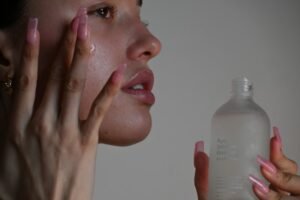My skin is dry, sensitive, and of course, acne-prone. I tend to break out when I get lazy with my exfoliation routine, those clogged pores catch up with me fast. My skincare layering routine changes depending on whether my skin’s reacting and dealing with breakouts, or if it’s living its best, healthy life.
In this guide, I’m sharing my personal experience on how to layer skincare for sensitive acne-prone skin and what’s most likely to work for you too, especially if your skin is sensitive or you’re dealing with breakouts. Whether you’ve been a little too aggressive with your salicylic or if it’s just how your skin is naturally, this routine has worked best for me.
Why layering matters?
Layering really does matter. Your skin absorbs creams and serums differently based on its texture and the order in which you apply them. The general rule is to go from thinner to thicker.
This way, lighter creams and water-based serums get absorbed first, and heavier creams and occlusive sit on top to lock everything in. If you get the order wrong, things can go sideways.
If you apply skincare in reverse such as thick creams first and then serum, your serum won’t work as efficiently, and you’re basically wasting it.
And since we’re talking about sensitive, acne-prone, or irritated skin, I’d suggest not applying serum directly to your skin, especially if it’s an active ingredient.
You’ll probably end up with irritation and redness. So, yeah, the right order of skincare and how to layer is super important, but it’s also key to think about your skin’s current condition. Is it dry? If so, apply a toner first. Is it sensitive? Then go for a gentle base underneath before applying any actives.
It honestly took me a while to realize that not every skincare routine fits every phase of my skin. I still remember my first experience with a serum that felt like it was doing nothing for me, only to later realize I was applying it in the wrong order and not giving it enough time to absorb before layering on other.
Triggers for sensitive acne-prone skin
Layering vitamin C and retinol can be a great combo, but if your skin’s reactive and sensitive, it’s not going to help and make things worse. Astringent toners while you’re dealing with breakouts and redness? They’ll just lead to more dryness and irritation.
Using too many actives at once, like retinol, AHAs, and BHAs. They can damage your skin barrier. And if your skincare has fragrance? Definitely a no-go for sensitive skin.
When you’re dealing with reactive skin, it’s best to look for fragrance-free and hypoallergenic serums and moisturizers. So yeah, these are some practices I avoid.
How to layer skincare
My skincare layering routine is pretty simple and gentle. You don’t need to overload your skin with tons of ingredients—I mostly focus on calming and hydrating ones, and just make sure I’m using them in the right order.
I’m not against a 10-step routine (honestly, it does give me glowing skin), but I only go for that when my skin barrier is intact and happy. When my skin’s reactive and sensitive, it really just needs a more basic routine. Done in the right order to keep things calm.
AM skincare routine
In the morning, I go in with a gentle, gel-based cleanser, something light and non-stripping. Honestly, cleansing in the morning is optional but I like starting with a clean base. After that, I follow up with a hydrating milky toner.
It dampens the skin and really helps with hydration. And trust me, toners aren’t just overpriced water. They’ve actually been a game changer for my skin.
Next, I apply a thin layer of hyaluronic acid. In the mornings, I usually skip actives altogether and just stick to hydrating serums. You can go for a hyaluronic-based serum or an essence and they both work great. I personally don’t see the need to layer both at once.
Then I move on to a lightweight moisturizer. Heavy ones tend to clog my pores, especially when my skin’s feeling reactive. When that’s the case, I also take a break from exfoliants and actives and keep things minimal.
And of course, I always finish with SPF. It’s non-negotiable. I recommend going for a physical sunscreen if your skin is sensitive or reactive. Chemical based sunscreen ones can sometimes just make things worse. If you have super sensitive skin Beauty of Joseon Relief Sun: Probiotics + Rice is really calming on irritated skin.
PM skincare routine
If you’ve been wearing makeup or even just sunscreen during the day, double cleansing at night kind of becomes mandatory. So that’s where I start my nighttime routine. After double cleansing, I go in with a toner, then an essence, and then niacinamide.
Now, niacinamide is a big deal and it really helps with breakouts. After that, I seal everything in with a moisturizer and call it a night. Simple.
You can use niacinamide in the morning too. I actually do every other day in my AM routine just to keep things basic. It’s especially great for oil regulation, so if you’ve got oily and sensitive skin, using it morning and night can really help.
Just make sure the concentration is under 5%. Anything higher doesn’t really work better, it just ups the chances of irritation.
Final thought
If your skin’s freaking out and your skincare shelf is starting to look like a chaotic little science lab and you’ve been layering actives on top of reactive skin? It’s probably time to take a step back. Let your skin breathe a little. Strip things down and keep your routine basic and gentle.
The right order of layering really matters. And honestly, you can even skip cleansing in the morning, especially if your skin prefers it that way.
Just remember, the general rule is to go from thinnest to thickest, and take a step back from harsh exfoliation if your skin’s feeling sensitive. Facial oils can be amazing for hydration if you’ve got dry skin, but if you’re oily, I’d say skip them as they can be a bit much.
And yes, they go in last. With this kind of routine, you’re definitely on your way to calm and hydrated skin.




